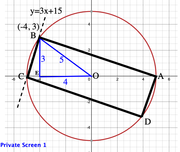Events & Promotions
| Last visit was: 24 Apr 2024, 12:03 |
It is currently 24 Apr 2024, 12:03 |

Customized
for You
Track
Your Progress
Practice
Pays
01:00 PM EDT
-11:59 PM EDT
10:00 AM PDT
-11:00 AM PDT
07:30 AM PDT
-12:00 PM PDT
08:30 AM PDT
-09:30 AM PDT
12:00 PM EDT
-01:00 PM EDT
03:00 PM PDT
-04:00 PM PDT
11:00 AM EDT
-12:00 PM EDT
11:00 AM IST
-01:00 PM IST
08:00 PM PDT
-09:00 PM PDT
05:30 AM PDT
-07:30 AM PDT
11:00 AM IST
-01:00 PM IST
12:00 PM PDT
-01:00 PM PDT
12:00 PM EDT
-01:00 PM EDT
Difficulty:


 95%
(hard)
95%
(hard)
Question Stats:
48% (03:30) correct 52%
(03:26)
wrong
52%
(03:26)
wrong  based on 970
sessions
based on 970
sessions
inscribed_rectangle.PNG [ 14.63 KiB | Viewed 38541 times ]

equation.JPG [ 18.41 KiB | Viewed 24585 times ]
File comment: Main Figure
Rectangle_in_Circle.JPG [ 25.11 KiB | Viewed 24588 times ]


|
|
||
|
Hi Generic [Bot],
Here are updates for you:
ANNOUNCEMENTS
Watch earlier episodes of DI series below EP1: 6 Hardest Two-Part Analysis Questions EP2: 5 Hardest Graphical Interpretation Questions
Tuck at Dartmouth
GMAT Club REWARDS
|